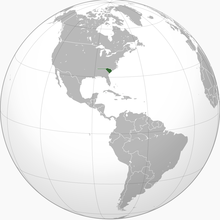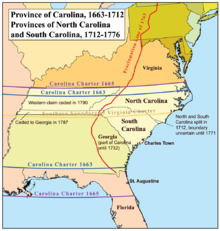Province of South Carolina
| Province of South Carolina | |||||||||
|---|---|---|---|---|---|---|---|---|---|
| Province of Great Britain | |||||||||
| 1712–1776 | |||||||||
 Location of South Carolina in North America | |||||||||
| Anthem | |||||||||
| "God Save the King"[a] | |||||||||
| Capital | Charlestown | ||||||||
| Area | |||||||||
| • Coordinates | 34°N 81°W / 34°N 81°W | ||||||||
| Government | |||||||||
| • Type | Proprietary colony (1712-1729) Crown colony (1729-1776) | ||||||||
| Monarch | |||||||||
• 1712–1714 | Anne | ||||||||
• 1714–1727 | George I | ||||||||
• 1727–1760 | George II | ||||||||
• 1760–1776 | George III | ||||||||
| Governor | |||||||||
• 1712 | Robert Gibbes (first) | ||||||||
• 1775–1776 | Lord William Campbell (last) | ||||||||
| Legislature | General Assembly | ||||||||
• Upper house | Council | ||||||||
• Lower house | Assembly | ||||||||
| Historical era | Georgian era | ||||||||
• Partition of Carolina | 24 January 1712 | ||||||||
• Charter of Georgia | June 9, 1732 | ||||||||
| 4 July 1776 | |||||||||
| |||||||||
| Today part of | United States
| ||||||||
The Province of South Carolina, originally known as Clarendon Province, was a province of the Kingdom of Great Britain that existed in North America from 1712 to 1776. It was one of the five Southern colonies and one of the thirteen American colonies of the British Empire. The monarch of Great Britain was represented by the Governor of South Carolina, until the colonies declared independence on July 4, 1776.
Etymology
"Carolina" is taken from the Latin word for "Charles" (Carolus), honoring King Charles II, and was first named in the 1663 Royal Charter granting to Edward, Earl of Clarendon; George, Duke of Albemarle; William, Lord Craven; John, Lord Berkeley; Anthony, Lord Ashley; Sir George Carteret, Sir William Berkeley, and Sir John Colleton the right to settle lands in the present-day U.S. states of North Carolina, Tennessee, South Carolina, Georgia, Alabama, Mississippi, and Florida.[2]
History

Charles Town was the first settlement, established in 1670.[3][4] King Charles II had given the land to a group of eight nobles called the lords proprietor; they planned for a Christian colony. Originally a single proprietary colony, the northern and southern sections grew apart over time, due partly to neglect by the legal heirs of the original lords proprietor. Dissent over the governance of the province led to the appointment of a deputy governor to administer the northern half of the Province of Carolina in 1691. The partition of the province into North and South Carolina became complete in 1712.[5]
The Yamasee War (1715–1717) ravaged the back-country of the province. Complaints that the proprietors had not done enough to protect the provincials against either the Indians or the neighboring Spanish, during Queen Anne's War (1702–1713), convinced many residents of the necessity of ending proprietary rule. A rebellion broke out against the proprietors in 1719. Acting on a petition of residents, King George I appointed the governor of South Carolina later in that year (the governors of North Carolina would continue to be appointed by the lords proprietor until 1729). After nearly a decade in which the British monarchy sought to locate and buy out the lords, both North and South Carolina became royal colonies in 1729.
Government
The Court of King's Bench and Common Pleas was founded c.1725, based in Charles Towne. List of Chief Justices:[6]
| Incumbent | Tenure | Notes | |
|---|---|---|---|
| Took office | Left office | ||
| Edmund Bohun | 1698 | 1699 | died in office of fever |
| Nicholas Trott | c.1702 | 1718 | dismissed from office after uprising |
| Richard Alleyn | 1719 | not sure | |
| Robert Wright | 1730 | 1739 | died in office |
| Thomas Dale | 17 Oct 1739 | November 1739 | not sure |
| Benjamin Whitaker | 7 Nov 1739 | 1749 | removed from office due to paralysis |
| James Graeme | 6 Jul 1749 | 29 August 1752[7] | died in office[8] |
| Charles Pinckney | 1752 | 1753 | |
| Peter Leigh | 1753 | ||
| James Michie | 1 Sep 1759 | 16 July 1760 | died in office, London, England |
| William Simpson | 24 Jan 1761 | ||
| Charles Skinner | 1762 | ||
| Thomas Knox Gordon | 13 May 1771 | ||
| William Henry Drayton | 13 Apr 1776 | ||
| John Rutledge | 16 Feb 1791 | 1795 | resigned and afterwards Chief Justice of the United States |
| after 1791 no further Chief Justices were appointed. | |||
| Year | Pop. | ±% |
|---|---|---|
| 1720 | 17,048 | — |
| 1730 | 30,000 | +76.0% |
| 1740 | 45,000 | +50.0% |
| 1750 | 64,000 | +42.2% |
| 1760 | 94,074 | +47.0% |
| 1769 | 125,000 | +32.9% |
| 1770 | 124,244 | −0.6% |
| 1775 | 150,000 | +20.7% |
| Source: 1720–1760;[9] 1769–1775[10] 1770–1775[11] | ||
See also
- Red, White, and Black Make Blue: Indigo in the Fabric of Colonial South Carolina Life
- Bibliography of South Carolina history
Notes
- ^ There was no authorized version of the national anthem as the words were a matter of tradition; only the first verse was usually sung.[1] No statute had been enacted designating "God Save the King" as the official anthem. In the English tradition, such laws are not necessary; proclamation and usage are sufficient to make it the national anthem. "God Save the King" also served as the Royal anthem for certain royal colonies. The words King, he, him, hiswere replaced by Queen, she, her when the monarch was female.
References
- ^ Berry, Ciara (January 15, 2016). "National Anthem". The Royal Family. Archived from the original on September 2, 2014. Retrieved June 4, 2016.
- ^ Poore, Ben. Perley, ed. (1877). The Federal and State Constitutions, Colonial Charters, and Other Organic Laws of the United States, Volume II. Washington: Government Printing Office. pp. 1382–1390. OCLC 958743486 – via Internet Archive.
- ^ McCrady, Edward (1897). The History of South Carolina Under the Proprietary Government, 1670-1719. Macmillan. p. 145. ISBN 9780722245941. Archived from the original on April 9, 2022. Retrieved April 9, 2022.
- ^ Gallay, Alan (2008). The Indian Slave Trade: The Rise of the English Empire in the American South, 1670-1717. Yale University Press. pp. 40–42. ISBN 978-0-300-13321-9. Archived from the original on April 9, 2022. Retrieved April 9, 2022.
- ^ D.J. McCord (1839). The Statutes at Large of South Carolina. Vol. 6. A.S. Johnston. p. 616. ISBN 978-5-87571-708-6.
- ^ The Statutes at Large of South Carolina. Vol. 1. A.S. Johnston. 1836. p. 439.
- ^ Salley, Alexander Samuel; Webber, Mabel L. (March 21, 2012). Death Notices in the South-Carolina Gazette 1732-1775/Death Notices in the South Carolina Gazette, 1766-1774. Genealogical Publishing Com. ISBN 978-0-8063-4656-4. Archived from the original on June 12, 2021. Retrieved November 19, 2020.
- ^ Anderson, Dorothy Middleton; Eastman, Margaret Middleton Rivers (May 4, 2015). St. Philip's Church of Charleston: An Early History of the Oldest Parish in South Carolina. Arcadia Publishing. ISBN 978-1-62585-407-0. Archived from the original on June 12, 2021. Retrieved November 19, 2020.
- ^ Purvis, Thomas L. (1999). Balkin, Richard (ed.). Colonial America to 1763. New York: Facts on File. pp. 128–129. ISBN 978-0816025275.
- ^ Purvis, Thomas L. (1995). Balkin, Richard (ed.). Revolutionary America 1763 to 1800. New York: Facts on File. p. 171. ISBN 978-0816025282.
- ^ "Colonial and Pre-Federal Statistics" (PDF). United States Census Bureau. p. 1168. Archived (PDF) from the original on October 30, 2022. Retrieved May 11, 2020.
Further reading
- Coclanis, Peter A., "Global Perspectives on the Early Economic History of South Carolina," South Carolina Historical Magazine, 106 (April–July 2005), 130–46.
- Crane, Verner W. The Southern Frontier, 1670-1732 (1956)
- Edgar, Walter. South Carolina: A History, (1998) the standard scholarly history
- Edgar, Walter, ed. The South Carolina Encyclopedia, (University of South Carolina Press, 2006) ISBN 1-57003-598-9, the most comprehensive scholarly guide
- Feeser, Andrea. Red, White, and Black Make Blue: Indigo in the Fabric of Colonial South Carolina Life (University of Georgia Press; 2013) 140 pages; scholarly study explains how the plant's popularity as a dye bound together local and transatlantic communities, slave and free, in the 18th century.
- Smith, Warren B. White Servitude in Colonial South Carolina (1961)
- Tuten, James H. Lowcountry Time and Tide: The Fall of the South Carolina Rice Kingdom (University of South Carolina Press, 2010) 178 pp.
- Wallace, David Duncan. South Carolina: A Short History, 1520-1948 (1951) online standard scholarly history
- Wright, Louis B. South Carolina: A Bicentennial History' (1976) online, popular survey
- Wood, Peter H. Black Majority: Negroes in Colonial South Carolina from 1670 Through the Stono Rebellion (1996)


